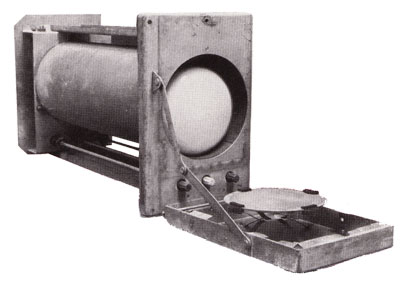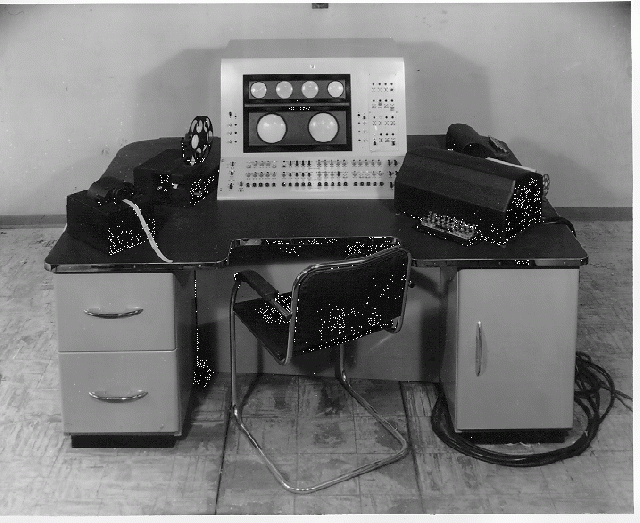Difference between revisions of "Ferranti Mark 1"
GerdIsenberg (talk | contribs) (Created page with "'''Home * Hardware * Ferranti Mark 1''' '''Ferranti Mark 1''',<br/> the world's first commercially available general-purpose electronic computer, produced b...") |
GerdIsenberg (talk | contribs) |
||
| Line 51: | Line 51: | ||
=References= | =References= | ||
<references /> | <references /> | ||
| − | |||
'''[[Hardware|Up one Level]]''' | '''[[Hardware|Up one Level]]''' | ||
| + | [[Category:Quotes]] | ||
Latest revision as of 14:44, 7 December 2019
Home * Hardware * Ferranti Mark 1
Ferranti Mark 1,
the world's first commercially available general-purpose electronic computer, produced by Ferranti [1]. The first machine was delivered to the University of Manchester in February 1951 [2]. Ferranti Mark 1 was a tidied up and commercialized version of the Manchester Mark 1 developed in 1948-1949 at the University of Manchester, which was a further development of the Manchester Small-Scale Experimental Machine (SSEM, nicked Baby) by Frederic C. Williams, Tom Kilburn and Geoff Tootill [3]. During the 1940s, Alan Turing and others such as Konrad Zuse developed the idea of using the computer's own memory to hold both the program and data. It was John von Neumann who became widely credited with defining that stored-program computer architecture, on which the Mark 1 was based [4] [5].
Contents
Memory
The Mark 1 used a 20-bit word stored as a single line of dots on a Williams-Kilburn tube, each tube storing 64 lines. Instructions were stored in a single word, while numbers were stored in two words (40 bits). The main memory had eight tubes, each storing one page of 64 words. Other tubes stored the single 80-bit accumulator (A), the 40-bit multiplicand/quotient register (MQ) and eight B-lines, or index registers, used to modify instructions. An extra 20-bit word per tube stored an offset value into the secondary storage, a 512-page magnetic drum.
Instructions
The 20 bit instructions had an address and an operator part. The coding of instructions was: bits 0-8 the CRT address, bits 10-12 the B-line address and bits 13-19 the function code. Writing of programs was based on a numerical system to the base 32 [7]. Integer numbers were usually treated as 40 bit double words, negative numbers already represented as Two's complement. The Mark 1 had an instruction to find the position of the most significant digit [8] aka Bitscan reverse or Leading Zero Count for the purpose to convert integers to normalized floating point numbers, as well as a Population Count instruction for Cryptography purposes [9]. Arithmetical and logical instructions other than multiplication took 1.2 milliseconds (5 x 240 microseconds beats ), 40*40=80 bit multiplication 2.16 milliseconds (9 beats) [10] [11].
Console
The two larger CRT displays could be switched to show the current contents of any of the 8 pages. The four smaller displays (presumably) permanently showed the current contents of the four auxiliary tubes, A (80-bit Accumulator), B (8 20-bit B-lines), C (Control Address and Present Instruction) and D (current multiplicand value). See the next picture and comment for the Input/Output equipment. [12]
Checkers
The first successful AI program was written in 1950/1951 by Christopher Strachey, initially for the Pilot ACE at National Physical Laboratory, exhaustings its memory [13]. Strachey’s checkers (draughts) program was soon ported and ran on the Mark I computer at the University of Manchester, and by the summer of 1952 the program could play a complete game of checkers at a reasonable speed [14] [15], and already featured Bitboards for White, Black and Kings to represent the board [16].
Chess
Alan Turing, while affiliated with the University of Manchester began "porting" his pen and paper program Turochamp to run on a Mark 1, as well started with Michie's and Wylie's program Machiavelli, but could not complete them [17]. Influenced by Turing's ideas, Dietrich Prinz developed the first limited chess program for the Ferranti Mark 1 in 1951, dubbed Mate-in-two [18] [19].
Quotes
In a letter to F C Williams in July 1951 I said "A facetious question is whether it is intended to display chess positions on the monitoring tubes". Of course today it is no longer at all facetious.
See also
Selected Publications
- Alan Turing (1949). Alan Turing's Manual for the Ferranti Mk. I. transcribed in 2000 by Robert Thau, pdf from The Computer History Museum
- Dietrich Prinz (1951). Introduction to Programming on the Manchester Electronic Digital Computer. [22] [23]
- Alan Turing (1951). Programmers' Handbook for the Manchester Electronic Computer Mark II. 1st edition
- Alan Turing (1952). Programmers' Handbook for the Manchester Electronic Computer Mark II. 2nd edition, revised by R.A. Brooker
External Links
- The Ferranti Mark 1 (Digital 60)
- Ferranti Mark 1 from Computer 50 - The University of Manchester Celebrates the Birth of the Modern Computer
- The Ferranti Mark I computer pdf from Museum of Science and Industry in Manchester
- The “Modern” History of Artificial Intelligence and Programs from Neuroscience Of Intelligence
- LoveLetters_1.0, 2009—...: by David Link » Christopher Strachey's love letters
References
- ↑ Ferranti: the Company from Atlas Computer Laboratory
- ↑ Ferranti Mark 1 - History and specifications, from Wikipedia
- ↑ Manchester Small-Scale Experimental Machine from Wikipedia
- ↑ Manchester Mark 1 - Background
- ↑ Von Neumann architecture from Wikipedia
- ↑ Williams tube from Wikipedia
- ↑ Programming the Mark 1
- ↑ Alan Turing (1949). Alan Turing's Manual for the Ferranti Mk. I. transcribed in 2000 by Robert Thau, pdf from The Computer History Museum, 9.4 The position of the most significant digit
- ↑ Cryptography is also a significant application of the /R function symbol, which counts the number of one bits in a word; Turing refers to this as the "sideways adder" in his quick-reference summary. from Alan Turing (1949). Alan Turing's Manual for the Ferranti Mk. I. transcribed in 2000 by Robert Thau, pdf from The Computer History Museum, 9.4 The position of the most significant digit
- ↑ Ferranti Mark 1 - Specification from Computer 50 - The University of Manchester Celebrates the Birth of the Modern Computer
- ↑ 11. The time occupied by various operations from Alan Turing (1951). Programmers' Handbook for the Manchester Electronic Computer Mark II. 1st edition
- ↑ The Ferranti Mark 1 from Mark 1 Photo Gallery, The two larger CRT displays could be switched to show the current contents of any of the 8 pages. The four smaller displays (presumably) permanently showed the current contents of the four auxiliary tubes, A (80-bit Accumulator), B (8 20-bit B-lines), C (Control Address and Present Instruction) and D (current multiplicand value). Copyright The University of Manchester 1998, 1999
- ↑ Christopher Strachey from Wikipedia
- ↑ artificial intelligence (AI) :: Early milestones in AI from Britannica Online Encyclopedia
- ↑ The “Modern” History of Artificial Intelligence and Programs from Neuroscience Of Intelligence
- ↑ On Bitboards for White, Black and Kings to represent the checkers board, see David Link Video at 1:04:02
- ↑ Chronology of Computing compiled by David Singmaster
- ↑ Dietrich Prinz (1952). Robot Chess. Research, Vol. 6, reprinted 1988 in Computer Chess Compendium
- ↑ First video game - 1947–1958: Chess, from Wikipedia
- ↑ Excerpts from Acceptance Speech for the 1998 Computer Pioneers Award from the IEEE - Jack Good hosted by Atlas Computer Laboratory
- ↑ Mark 1 Documents from Computer 50 - The University of Manchester Celebrates the Birth of the Modern Computer
- ↑ Papers of Dr Dietrich G. Prinz - ELGAR: Electronic Gateway to Archives at Rylands The John Rylands University Library The University of Manchester
- ↑ UK National Archive for the History of Computing - Draft Catalogue Version 1.0, August 15, 2005 (pdf)

